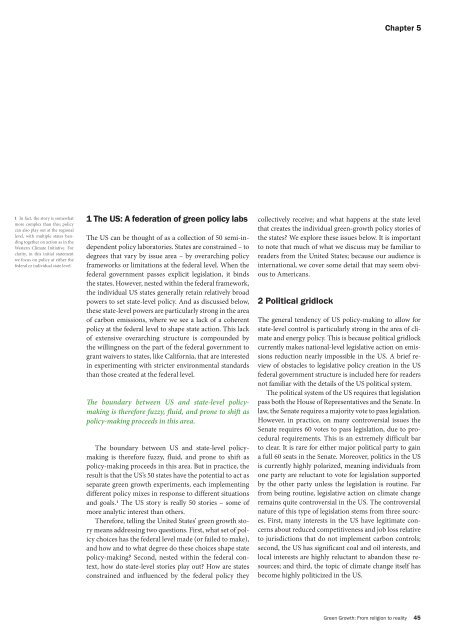GREEN GROWTH: FROM RELIGION TO REALITY - Sustainia
GREEN GROWTH: FROM RELIGION TO REALITY - Sustainia
GREEN GROWTH: FROM RELIGION TO REALITY - Sustainia
- No tags were found...
Create successful ePaper yourself
Turn your PDF publications into a flip-book with our unique Google optimized e-Paper software.
Chapter 51 In fact, the story is somewhatmore complex than this; policycan also play out at the regionallevel, with multiple states bandingtogether on action as in theWestern Climate Initiative. Forclarity, in this initial statementwe focus on policy at either thefederal or individual state level.1 The US: A federation of green policy labsThe US can be thought of as a collection of 50 semi-independentpolicy laboratories. States are constrained – todegrees that vary by issue area – by overarching policyframeworks or limitations at the federal level. When thefederal government passes explicit legislation, it bindsthe states. However, nested within the federal framework,the individual US states generally retain relatively broadpowers to set state-level policy. And as discussed below,these state-level powers are particularly strong in the areaof carbon emissions, where we see a lack of a coherentpolicy at the federal level to shape state action. This lackof extensive overarching structure is compounded bythe willingness on the part of the federal government togrant waivers to states, like California, that are interestedin experimenting with stricter environmental standardsthan those created at the federal level.The boundary between US and state-level policymakingis therefore fuzzy, fluid, and prone to shift aspolicy-making proceeds in this area.The boundary between US and state-level policymakingis therefore fuzzy, fluid, and prone to shift aspolicy-making proceeds in this area. But in practice, theresult is that the US’s 50 states have the potential to act asseparate green growth experiments, each implementingdifferent policy mixes in response to different situationsand goals.1 The US story is really 50 stories – some ofmore analytic interest than others.Therefore, telling the United States’ green growth storymeans addressing two questions. First, what set of policychoices has the federal level made (or failed to make),and how and to what degree do these choices shape statepolicy-making? Second, nested within the federal context,how do state-level stories play out? How are statesconstrained and influenced by the federal policy theycollectively receive; and what happens at the state levelthat creates the individual green-growth policy stories ofthe states? We explore these issues below. It is importantto note that much of what we discuss may be familiar toreaders from the United States; because our audience isinternational, we cover some detail that may seem obviousto Americans.2 Political gridlockThe general tendency of US policy-making to allow forstate-level control is particularly strong in the area of climateand energy policy. This is because political gridlockcurrently makes national-level legislative action on emissionsreduction nearly impossible in the US. A brief reviewof obstacles to legislative policy creation in the USfederal government structure is included here for readersnot familiar with the details of the US political system.The political system of the US requires that legislationpass both the House of Representatives and the Senate. Inlaw, the Senate requires a majority vote to pass legislation.However, in practice, on many controversial issues theSenate requires 60 votes to pass legislation, due to proceduralrequirements. This is an extremely difficult barto clear. It is rare for either major political party to gaina full 60 seats in the Senate. Moreover, politics in the USis currently highly polarized, meaning individuals fromone party are reluctant to vote for legislation supportedby the other party unless the legislation is routine. Farfrom being routine, legislative action on climate changeremains quite controversial in the US. The controversialnature of this type of legislation stems from three sources.First, many interests in the US have legitimate concernsabout reduced competitiveness and job loss relativeto jurisdictions that do not implement carbon controls;second, the US has significant coal and oil interests, andlocal interests are highly reluctant to abandon these resources;and third, the topic of climate change itself hasbecome highly politicized in the US.Green Growth: From religion to reality 45



